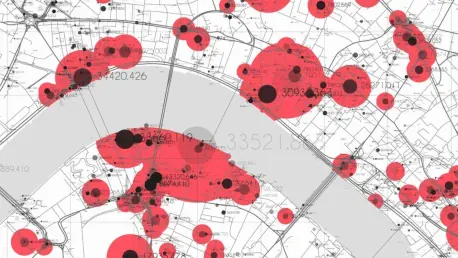Air pollution in India’s urban areas has long been a critical issue, affecting millions of lives and posing significant health risks. By leveraging hyperlocal air quality monitoring and advanced data analytics, a groundbreaking report by Respirer Living Sciences has shed new light on this problem. Combining these two approaches has revealed intricate pollution patterns at the city level, offering unprecedented insights into the real-time state of air quality across ten major Indian cities.
The Importance of Hyperlocal Monitoring
Understanding Localized Pollution Sources
Hyperlocal monitoring involves collecting air quality data at a very granular level, often down to specific neighborhoods or streets. This method contrasts with traditional monitoring systems that provide broader regional averages. By focusing on localized data, researchers can identify specific pollution sources, such as industrial emissions, vehicular traffic, and construction dust, which may not be apparent in broader assessments. This detailed analysis has shown that urban air pollution in India is highly localized and varies significantly from one area to another.
In Delhi, hyperlocal data revealed severe pollution levels in areas like Anand Vihar and Jahangirpuri, where PM2.5 levels exceeded 300 µg/m³. These hotspots were primarily driven by industrial emissions and heavy vehicular traffic. Conversely, Mumbai experienced moderate pollution levels, with hotspots like Shivaji Nagar and Kandivali, where PM2.5 concentrations were driven by construction dust and waste processing activities, surpassing 100 µg/m³. These findings underscore the importance of hyperlocal monitoring in identifying and addressing specific pollution sources. Unlike traditional methods that rely on regional averages, hyperlocal data provides critical insights into the exact areas that need targeted interventions, thus making mitigation efforts more effective.
Case Studies: Delhi and Mumbai
Delhi’s situation is particularly alarming due to the high volume of industrial activities and traffic congestion. In areas like Anand Vihar and Jahangirpuri, PM2.5 levels have consistently exceeded 300 µg/m³, pointing to severe air pollution issues. The report highlighted that localized monitoring can pinpoint the exact sources contributing to these high levels, such as specific factories or busy traffic intersections. On the other hand, Mumbai faced moderate pollution levels with notable hotspots like Shivaji Nagar and Kandivali. Here, the PM2.5 concentrations that surpassed 100 µg/m³ were largely attributable to construction dust and waste processing activities.
The case studies in Delhi and Mumbai illustrate how hyperlocal data can identify the primary sources of pollution in different areas. By understanding these localized pollution sources, policymakers can implement targeted emission controls that directly address the contributing factors. For instance, restrictions on industrial emissions in areas like Anand Vihar in Delhi could significantly reduce pollution levels. Similarly, better waste management practices and regulations on construction activities in Mumbai’s hotspots could mitigate the pollution problem. The localized approach ensures that interventions are not only timely but also more efficient in achieving cleaner air.
Seasonal and Regional Variations
Impact of Seasonal Changes
The study also highlighted significant seasonal impacts on air quality in cities like Kolkata and Patna. During certain times of the year, air quality deteriorated due to the burning of crop residues and aged transportation infrastructure. Specific areas such as Sealdah and Samanpura were notable for their elevated PM2.5 levels during these periods. Understanding these seasonal variations is crucial for implementing timely and effective interventions. These variations often result from agricultural practices and the state of local infrastructure, which can lead to temporary but severe increases in air pollution levels.
Seasonal changes often exacerbate existing pollution problems, making it essential for cities to adopt flexible strategies. For instance, in Kolkata, the burning of crop residues during particular seasons has led to spikes in PM2.5 levels, significantly impacting air quality. The study pointed out that proactive measures, such as enforcing stricter regulations on crop burning and improving the transportation infrastructure, could help mitigate these seasonal impacts. Similarly, Patna’s aged transportation infrastructure has been identified as a significant contributor to poor air quality during certain times of the year. Upgrading these systems could effectively reduce pollution levels, showcasing the need for seasonal and region-specific approaches.
Regional Differences in Pollution Patterns
Cities like Bengaluru and Chennai generally exhibited cleaner air but encountered spikes in pollution in specific zones like Peenya and Manali due to concentrated industrial activities and traffic. Meanwhile, Pune, Pimpri-Chinchwad, Hyderabad, and Chandigarh faced critical hotspots tied to rapid urbanization, insufficient green buffers, and significant industrial activity. These regional differences highlight the need for tailored approaches to air quality management. For example, Bengaluru and Chennai’s relatively cleaner air can be attributed to effective local policies and green buffers that reduce pollution levels.
However, specific zones within these cities still face challenges due to concentrated industrial activities. In contrast, cities like Pune and Pimpri-Chinchwad are grappling with the impacts of rapid urbanization and inadequate green spaces to act as pollution buffers. This underscores the importance of city-specific strategies for air quality management. For instance, increasing green infrastructure in rapidly urbanizing areas could help mitigate the adverse effects of rapid industrial growth. Similarly, implementing stricter emission controls in identified hotspots can significantly improve air quality. The regional variations in pollution patterns demand a flexible and targeted approach to effectively address the unique challenges each city faces in combating air pollution.
Technological Advancements in Air Quality Monitoring
Integration of Advanced Platforms
The report utilized the AtlasAQ platform from CPCB’s November 2024 data, augmented with spatial insights from Google Maps Air Quality API and Google’s AirView+ initiative. This integration of multiple data sources, including sensors, traffic, and satellite data, provided a more detailed and actionable understanding of air quality. Such advanced platforms enable more precise identification of pollution sources and facilitate targeted interventions. By leveraging diverse data inputs, these platforms can offer a comprehensive view that is far more informative than traditional monitoring methods.
This integration is particularly beneficial for identifying transient pollution sources that might otherwise go unnoticed. For instance, data from satellite images can pinpoint areas experiencing sudden spikes in pollution due to temporary construction projects or seasonal agricultural activities. Meanwhile, real-time data from sensors can provide continuous monitoring of traffic-related emissions, enabling timely interventions. The combination of various data sources ensures that the monitoring system is robust, providing actionable insights that can help policymakers implement effective air quality management strategies. Such technological advancements are crucial for tackling the complex and ever-changing nature of urban air pollution.
Role of Data Analytics
Advanced data analytics played a crucial role in decoding intricate pollution patterns at the city level. By analyzing hyperlocal data, researchers could pinpoint high-risk areas and design more effective public health interventions. This approach bridges the gap between broad-scale assessments and localized realities, offering a robust foundation for creating healthier urban environments. The use of sophisticated algorithms and machine learning techniques allows for the rapid processing of vast amounts of data, turning raw information into meaningful insights.
These analytics can identify trends and correlations that might not be immediately obvious, such as the impact of specific industrial activities on local air quality. Furthermore, predictive analytics can forecast future pollution levels based on current data trends, enabling proactive measures to be taken before conditions worsen. This capability is particularly valuable for cities with rapidly changing pollution dynamics, as it allows for real-time adjustments to intervention strategies. By leveraging the power of advanced data analytics, cities can develop more nuanced and effective air pollution control measures that adapt to the evolving landscape of urban environments.
Recommendations for Combating Urban Air Pollution
Targeted Emission Controls and Low-Emission Zones
The report emphasized the need for targeted emission controls and the expansion of low-emission zones. Implementing stricter regulations to reduce emissions from significant sources like automobiles and factories is highly recommended. Pedestrian-friendly zones and low-emission areas in densely populated regions could also contribute significantly to mitigating pollution levels. By focusing on high-risk areas identified through hyperlocal monitoring, these measures can be highly effective in reducing overall pollution.
For instance, creating low-emission zones in areas with heavy traffic congestion can immediately improve air quality. Additionally, incentivizing the use of public transportation and non-motorized transport options like cycling and walking can further reduce vehicular emissions. Similarly, implementing stricter emission standards for factories located in urban areas can help control industrial pollution. These targeted measures require a combination of regulatory enforcement and public awareness to be effective. By prioritizing high-pollution areas, policymakers can ensure that resources are allocated efficiently, making a significant impact on urban air quality.
Incorporation of Green Infrastructure
Incorporating green infrastructure, such as parks and green belts, can serve as natural pollution buffers. These green spaces help absorb pollutants and improve air quality, providing a healthier environment for urban residents. The report highlighted the importance of expanding green infrastructure in rapidly urbanizing areas to counteract the effects of industrial and vehicular emissions. Green spaces not only improve air quality but also offer numerous other benefits, such as enhancing urban aesthetics and providing recreational areas for residents.
Implementing green infrastructure in high-pollution areas can significantly reduce the concentration of harmful pollutants. For instance, planting more trees along busy roads can absorb vehicular emissions, while parks and green belts can act as barriers that prevent industrial pollutants from spreading to residential areas. Additionally, creating urban green spaces can promote biodiversity and improve the overall quality of life for city dwellers. By prioritizing the incorporation of green infrastructure in urban planning, cities can create sustainable environments that balance development with ecological health.
Enhancing Public Awareness and Engagement
Real-Time Data Tools and Educational Campaigns
Mobile applications and digital platforms offering real-time air quality data can empower individuals to make informed decisions about their daily activities. By fostering public awareness about the causes and effects of air pollution through educational initiatives, a culture of environmental consciousness can be promoted. Such public involvement is crucial for driving collective action towards cleaner cities. Real-time data tools can provide alerts about high pollution levels, allowing people to take preventive measures such as wearing masks or avoiding outdoor activities during peak pollution times.
Educational campaigns can further strengthen these efforts by informing the public about the sources of air pollution and the steps they can take to reduce their own contributions. For example, promoting the use of public transportation over private vehicles can significantly reduce vehicular emissions, while encouraging proper waste disposal can minimize pollution from waste processing activities. By integrating real-time data and educational campaigns, cities can create a well-informed citizenry that actively participates in pollution reduction efforts. Public engagement in these initiatives not only enhances their effectiveness but also fosters a sense of communal responsibility for environmental health.
Promoting Environmental Consciousness
Air pollution in India’s urban regions has been a critical issue for years, impacting millions of lives and presenting serious health hazards. A groundbreaking report by Respirer Living Sciences has highlighted this long-standing problem by utilizing hyperlocal air quality monitoring alongside advanced data analytics. These methods have uncovered complex pollution patterns within cities, giving us detailed insights into the real-time status of air quality in ten major Indian cities. This combination of technology and data has revealed the extent of the problem more clearly than ever before, demonstrating how deeply ingrained pollution is in these urban environments. The report emphasizes the need for immediate action to address these hazardous conditions, which affect both the health of residents and the overall environmental well-being of the cities. This detailed monitoring and analysis can inform policymakers and health officials as they work towards implementing effective strategies to combat air pollution and safeguard public health.









